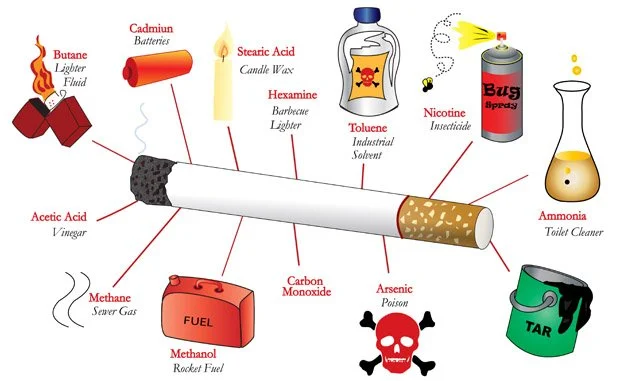Smoking Cessation Part 1
In Vitalis we are lucky to have a very experienced clinician Tina Fagan who worked as a smoking cessation advisor for many years. To precede a series of blogs where Tina is interview about her experience, this blog gives some background detail on smoking cessation, what it is and how it works.
The side effects of smoking tobacco only became noticeable in the 1920s. Many of these adverse effects and life-limiting illnesses are caused by the 4000+ chemicals involved. The widespread effects of tobacco smoking affect the whole body as well as common smoking-related conditions such as chronic obstructive pulmonary disease (COPD) and lung cancer. Second-hand exposure to other people’s tobacco smoke is also a cause of ill health. Smoking in pregnancy can also cause harm as well as risks to children’s future health.
Third hand exposure comes from contamination of surfaces with smoke particles. One example of third hand exposure is when smoking close to a furry pet such as a dog, the particles collect in the fur and then can be inhaled/ digested when petting e.g. a child cuddling them. The pet themselves can also be exposed when grooming themselves and are also very susceptible to second hand smoking damage due to smaller lungs (similar to babies and children).
Smoking is a relapsing addiction and many people have 6–7 attempts before quitting long term. Smoking cessation is the name given to the process of supporting people to stop smoking. This usually involves a combination of behavioural support and some kind of nicotine replacement therapy and/or medication.
Content of therapy — A common feature of the various formats of smoking cessation therapy is that they equip the smoker with information about expected challenges during quit attempts and strategies to deal with them. Effective therapies generally begin before the patient's quit date to educate them about withdrawal symptoms and effective techniques to use while stopping smoking, as well as techniques to use to maintain abstinence.
Techniques from cognitive-behavioral therapy (CBT) offer keys to successful quitting. These techniques include learning to identify and avoid smoking triggers and developing tools to deal with situations that may tempt smoking. Other components of CBT include education about self-monitoring, reducing cigarette intake gradually in preparation for quitting (although some smokers choose to quit abruptly), and setting a quit date. Effective therapy includes social support delivered as part of treatment to reinforce a smoker's confidence in his or her ability to quit. Ideally, all the elements of CBT for smoking cessation should be incorporated into a treatment plan.
Identification of triggers — An important goal of behavioural support is to help smokers identify their triggers to smoke. The smoker anticipating quitting should be encouraged to identify situations, internal states, or activities that may increase the risk of continuing to smoke or of relapsing. Examples of common triggers include stressful situations, being around other smokers, consuming alcohol, or drinking coffee.
Problem solving and coping skills — Once smokers have identified situations that trigger them to smoke, they should engage in problem solving and practice coping skills to deal with such problems.
Examples of coping strategies include
●Exercise – Use exercise as an outlet and a way to address post-smoking cessation weight gain.
●No-smoking zones – Enact no-smoking policies for home and car to lessen time spent with smokers.
●Behavioural distraction – Engage in repetitive or simple activities (eg, doodling, knitting).
●Cognitive distraction – Think about what needs to be done (eg, for work, errands). Make a to-do list of priorities.
●Oral strategies – Chew gum, drink a glass of water or have a small, healthy snack.
●Positive self-talk and visualisation – Think "this will get easier," or visualise yourself not smoking.
Stress management and relaxation strategies — Stress is a commonly reported barrier to quitting smoking and maintaining abstinence. Clinicians can encourage patients to be aware of stress-related symptoms that they experience as a significant trigger to smoke (eg, muscle tension, irritability, difficulty concentrating, drinking alcohol), and to practice strategies to counter stress and avoid smoking.
Positive encouragement and support are crucial in promoting healthy behavior change. Clinicians can provide encouragement in many ways during a quit attempt, including:
●Communicating belief in the patient’s ability to quit
●Providing education about quitting, such as explaining that one-half of people who ever smoked have now successfully quit
●Communicating caring and concern by asking about emotions and fears about quitting and offering willingness to help
●Discussing the quitting process, including concerns, motivators, and difficulties throughout the process
If you would like tailored support to empower you to live a healthier life then book an appointment in our Belfast City Centre clinic. We are open all of the working week. Our clinic is bright and airy filled with plants and soft music to make you feel at ease. We receive patients from all over the world who are passing through Belfast, Howard Street, when staying at the Europa Hotel, Jurys Inn and the Fitzwilliam Hotel. We can give you last minute appointments, often same day or next day appointments to suit your busy schedule. Our doctors and clinicians are highly experienced and empathetic.
In Vitalis we are lucky to have a very experienced clinician Tina Fagan who worked as a smoking cessation advisor for many years. Her own experience as a smoker who was able to quit gave her particular empathy when working with patients. Check out the forthcoming blogs for an interview with Tina about her experiences.
Tina Fagan, health clinician at Vitalis Health.





